Reimagining the roads of Mahurangi
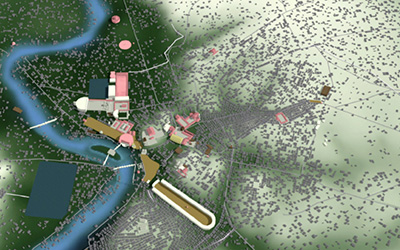
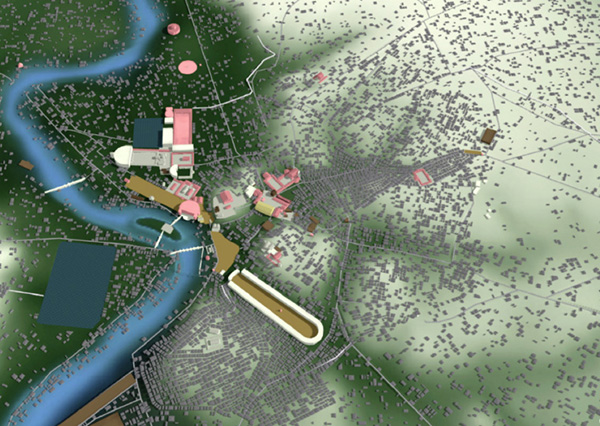
Making Rome Great Again: Augustus, of the city-of-marble, make-Rome-great-again proclivities, effected a step-change in energy-efficient transport infrastructure—critical when puny mammalian muscle was all that was available to power locomotion. Since, fossil fuel has facilitated the building of 36 million kilometres of much less energy-efficient roads, resulting in road transportation being the single greatest driver of anthropogenic global warming. The Labour Party’s $2.8 billion-per-year transportation plan is a welcome move towards greater energy efficiency, but—with its preoccupation with vanquishing congestion—it is not the step-change essential to salvaging a survivable climate, which cannot be allowed to play second fiddle to freeing up the roads for electric cars to clog. Shown in pink, the marble buildings that Augustus can take credit for. rendering Dr Diane Favro – professor of architecture and urban design ucla
Roads, historically, were not about cars. They were not even about private vehicles, until the last 100 of human civilisation’s 5500-year existence.
So perhaps the Labour Party’s pandering to Penlink is understandable, as it seeks to wrest more of the centre off National. The fact that it doesn’t begin to square with Prime Minister Jacinda Ardern’s climate nuclear-free moment will go unremarked on by the mainstream media, and uncriticised by those grateful for even timid discouragement of fossil-fuel use.
The eventual 400 000-kilometre network of roads masterminded bybut not invented by Augustus two millennia back was the most famous, until Hitler appropriated the autobahn initiative, however, neither were built for private enjoyment, but as strategic state infrastructure. In contrast, New Zealand’s contemporary road network was built very much on the belief that the private car was the future. Hilariously, it seems Homo sapiens sapiens is so utterly imprinted by personal transport, that, at a time when energy of any source must be used extremely sparingly, flying cars are fondly anticipated.
If folk are frustrated now by road congestion, licencing flocks of flying cars—aside from ever-destined to be the preserve of the wealthy—would result in aerial bedlam, and not just during high-wind events. The reason that flying is affordable, albeit at grave cost to a survivable climate, is scale. Fully loaded, a six-seater Cessna 310 consumes nearly half as much again energy per person as a Boeing 747. Meanwhile, the most popular ever small plane is the 4-seater Cessna 172, of which only 43 000 have been built. In contrast, more than a thousand times as many44.1 million Toyota Corollas have cascaded from the production lines. This, of course, is partly to do with utility, but is also a lot to do with the fact that for the price of a single 172, a fleet of Corollas conveying 20 times more people—or even more, with three in the back—could be puchased.
Unlike road vehicles, and boats, flying machines require energy just to stay afloat, as it were. If there is to be an energy miracle—beyond the energy miracle that France deployed to provide the world’s lowest-carbon electricity—it will be fusion-powered. But the cheap, clean energy will only be that if it is distributed by wires. Which is the fossil-fuel-free, real-world solution to Whangaparāoa Peninsula transport, implementable now: trolley buses. And public transport is famously cost-effective when it can’t be readily by-passedeven cars rat-run other cars, by the private car. Labour, however, blunders about, throwing three billion dollars at light rail to airport, Penlink, and Mill Road—money that could literally electrify the entirety of Auckland’s public transit.
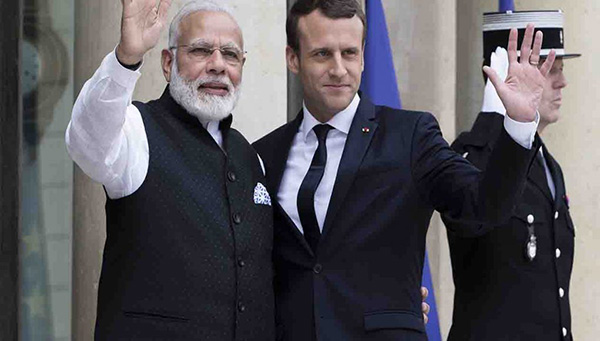
Climate Good Guys: Fortunately for the prospects for salvaging a survivable climate, French President Emmanuel Macron understands the need for nuclear power, if there is to be a meaningful move to fossil-fuel-free electricity generation. Given that India produces more than 500 times more coal than France, and that India’s increasingly energy-demanding population is projected to surpass that of China by 2024, either Prime Minister Narendra Modi, or President Macron, should explain to New Zealand’s prime minister why nuclear-free-power smugness is misplaced. Celebrated in this photograph, France is helping India build a 9.6-gigawatt nuclear power plant, which will be the world’s largest. image Global Village Space
Councils and council-controlled organisations, governments and state-owned enterprises, however, are ultra-averse to investing in infrastructure. Part of this is mind-set. It is supposedly foolish to invest in long-term solutions, because ‘nobody knows what’s around the corner’. Electronics miniaturisation and the sudden ubiquity of the internet is supposed to prove that planning for anything is futile. But the internet was planned, or at least its precursor was, by the United States’ Defense Advanced Research Projects Agency, and the autobahns were going nowherenot literally, in that the longest section connected Cologne and Bonn, but it was only 20 kilometres in length without the might of the Third Reich behind them. Miniaturisation, meantime, can only do so much for transport, short of miniaturising human beings. The solution is minimisation of travel, and wired electrification of the rest. Powering transportation wirelessly is, by comparison, wantonly extravagant, and plain unnecessary, and often promoted by people who would rather see the climate become unliveable, than be seen climbing aboard a bus with the great unwashed.
And to put the boot in, bus congestion is currently being used as a bogey to justify light rail to the airport. But the congestion only exists because, at traffic lights, almost without exception, cars—electric or otherwise—which monopolise more than four kilometres more roadway than a single double-articulated trolleybus, are granted equal priority. Wielding that sort of privilege, little wonder the demand for Teslas is undiminished, regardless their hefty price tag—despite the company’s debt-to-equity ratio of 543%. The $2.3 billion Dominion Road light rail, with its stops an inhuman nearly one kilometre apart, is a Labour vanity and a diversion of the funds needed to get busways ahead of the curve. Setting aside the scandal of the pristine parking spaces sitting idle at Silverdale, thanks to a delay in having them consented, work has only just started on the final busway leg to the Albany Busway Station, despite its instant popularity when it opened more than 12 years ago.
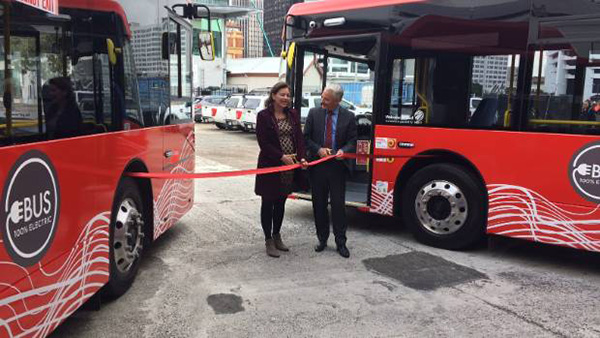
Serendipitously Red: Resplendent in Labour Party red, the standard livery of the CityLink route, Associate Transport Minister Julie Anne Genter and former Labour leader Mayor Phil Goff cut a red ribbon, obliviously symbolising the expensive plug-in option for propelling electric buses. The cost, $1.7 million, would have put a pair of diesel double-deckers on the road capable of moving twice the number of passengers. While that comparison is literally doubly odious, elsewhere, the NexGen trolleybus is said to cost only 63% more than a standard diesel, but has a 20-year, 1.3-million-kilometre life compared to the diesel’s 12-year, 0.8 million one, and runs for 25 kilometres off-wire fully loaded at 80 kilometres per hour—a far more intelligent utilisation of battery storage, and a bus that can operate around the clock without charging downtime. image Stuff
Warkworth, with current thinking, would become the mother of all park and rides. Folk would drive from not just within Warkworth, but from the Mahurangi Peninsula, from Matakana and Leigh, from Wellsford, and from as far as Mangawhai. If anything like the size of terminally undersized Albany Busway Station car park, it would consume an area almost as great as that occupied by Warkworth’s largest manufacturer, whose site is bulging at seams. The opportunity is ripe, at this early stage of the satellite growth centre’s structure-plan process, to plan for better than park-and-ride. And not just better for the prospects of a survivable climate, but better for existing and new businesses, whereby commuters, for example, can be dropped home to the door, or go home via a local store, bar or restaurant, door-to-door, without the time-wasting hassle of driving and parking. Meantime, for those with no option but to park-and-ride, their parking space would be much closer to their home in Mangawhai, Matakana, Wellsford or wherever.
With Labour caving on Penlink, having caved, under former Auckland mayor Len Brown on the what fellow Labour local-council politician Mike Lee famously derided as the Holiday Highway, Auckland Council would need to be fabulously forward-thinking to support a car-optional, much less, car-free, Warkworth. Mind, Mayor Phil Goff has recently posed with Associate Transport Minister Julie Anne Genter to launch a couple of battery-powered buses. Putting aside that the same $1.71 million would have purchased two diesel double-deckers, and that there are smarter uses for batteries, crucially, as range extenders for trolleybuses, what could convince the council is if Warkworth calls for fit-for-purpose transportation options, fit for today’s fight for the climate. The brave new Warkworth, given the opportunity to build for a zero-carbon future, now, would instantly become the most-visited small town in Aotearoa, after Arrowtown, for all the right reasons. And, soberingly, the permanent population being planned for will eclipse that of Queenstown.
If the scientific world was to sidestep the Intergovernmental Panel on Climate Change—which it so readily could, thanks to the internet—and produce, unhampered by the self-interest of individual governments, timely and robust assessments, Auckland’s leaders would know it was nuts to continue to build on land that had only an outside chance of remaining occupiable, long term. But if those masterminding the Christchurch rebuild couldn’t or wouldn’t acknowledge the inevitability of land only four or five metres above sea level being permanently inundated, Auckland’s politicians, unless uncharacteristically courageous, are going to be most loath to suggest that the long-term centre for the metropolis must be 60 kilometres south of its current, low-lying isthmus location.
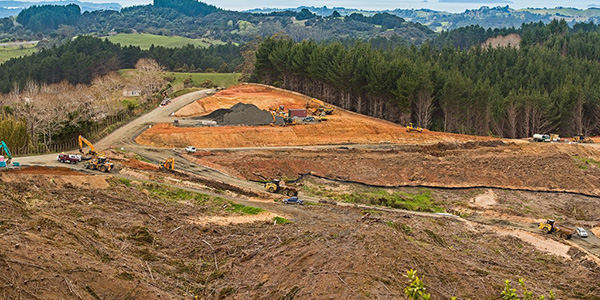
Roads of Global Significance: Never shy to stamp its party name on an enterprise, National’s vainglorious ‘roads of national significance’, alas, are of global impact, given the failure of carbon dioxide to respect national borders. The land here at Moir Hill might be comfortably above maximum sea level, but the Johnstone Hill Tunnels would flood if even half that maximum sea-level rise was realised, along with much of the new motorway, and thanks to the prevailing business-as-usual, nothing-to-see-here-folks mind-set, all bets are off. It is ironic in the extreme that minds can revel in the science-fiction nonsense of teleporting, yet give scant credence to entirely plausible scenarios, such as the loss of what once could be confidently termed permanent ice sheets, which, geologically, of course, are demonstrably ephemeral. image Fletcher Construction
But while the metropolis itself is only likely to double in population, in the next 50 years, Warkworth, it has been ordained, must quintuple, in the same timeframe, making it, to all intents and purposes, a new town. At first blush, terrain would rule out creating a site for Warkworth of sufficient elevation to guarantee its feet remained dry long term. But with irony that will not be appreciated by future generations, there is no official contemplation of anything so radical, yet the landscape in that very area is being radically reshaped to create further motorway, to encourage an even greater volume of, and dependence on, fossil-fuelled road transport.
The fossil fuel required to move the 12 million cubic metres of earth and rock involved, and that which will be burned by the additional, predominantly fossil-fueled, vehicle movements generated, will contribute to accelerating sea-level rise. But given that both the motorway and the satellite-growth-centre decisions were made in the prevailing vacuum of short-termism, the best that can now be salvaged is busway electrification and a walkable Warkworth.
All that is required is to reimagine roads and put cars firmly in their very useful place. Just because cars defined the last century of civilisation, doesn’t mean they should be permitted to make this century civilisation’s last.
Last word goes to Emmanuel Macron who, it appears, has persuaded Donald Trump not to undo the magnificent progress made by Barack Obama to limit nuclear weapons proliferation in Iran, but equally, he has refused to pander to the Greens on nuclear power, as did Angela Merkel, with such counterproductive consequences for the climate:
My priority, in France, Europe and internationally, is CO2 emissions and [global] warming … What did the Germans do when they shut all their nuclear in one go? They developed a lot of renewables but they also massively reopened thermal and coal. They worsened their CO2 footprint, it wasn’t good for the planet. So I won’t do that.
